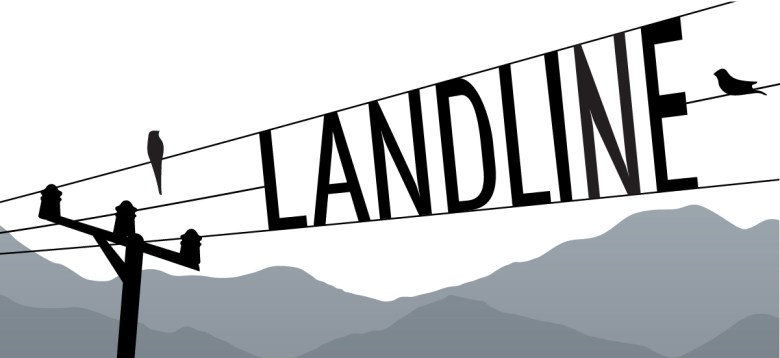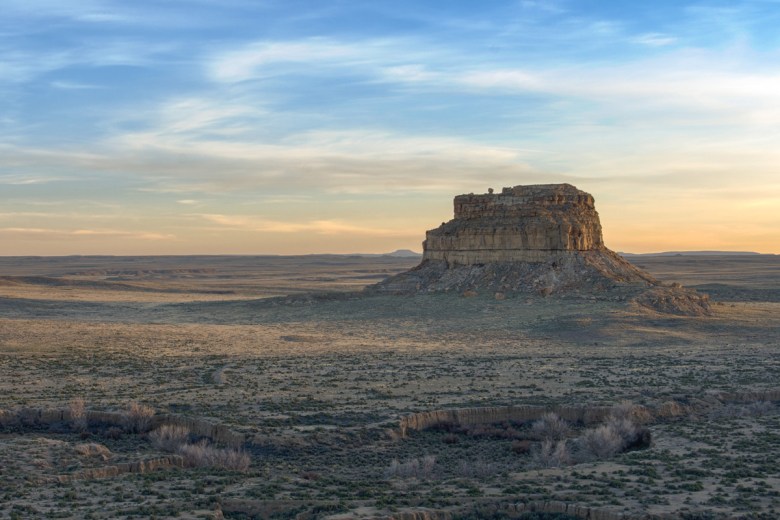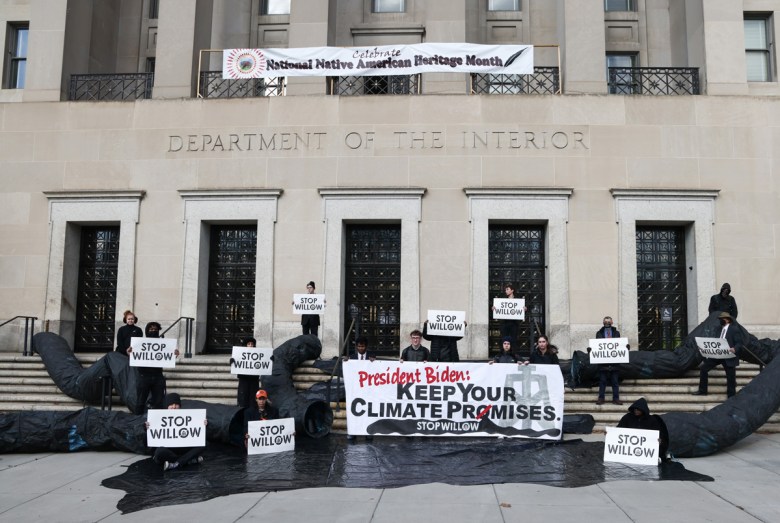
This is an installment of the Landline, a monthly newsletter from High Country News about land, water, wildlife, climate and conservation in the Western United States. Sign up to get it in your inbox.
A couple of weeks ago, I stumbled on a Republican National Committee diatribe in the Patriot Post titled “Biden Accelerates War on American Energy.” Just days later, the College Democrats of America, the Democratic National Committee’s collegiate arm, blastedthe Biden administration for its “indifference” to climate change and for failing to fulfill a campaign promise to end drilling on public lands.
Differing interpretations of federal policy are common, especially where our two major parties are concerned. But such diametrically opposed takes prompt us to wonder: Is Joe Biden deliberately murdering the oil and gas industry, or is he quietly trying to kill the planet?
Consider just a few of the administration’s more significant climate and conservation endeavors. In 2023, in no particular order, the Biden administration:
Established the Baaj Nwaavjo I’tah Kukveni-Ancestral Footprints of the Grand Canyon National Monument in northern Arizona, thereby protecting nearly 1 million acres from potential uranium mining.
Banned — for the next 20 years — new oil and gas leasing within a 10-mile radius of New Mexico’s Chaco Culture National Historical Park and canceled Trump-era oil and gas leases in Alaska’s Arctic National Wildlife Refuge.

Proposed withdrawing nearly 4 million acres of federal land from new oil and gas leases in western Coloradoand Wyoming’s Red Desert.
Finalized a plan to declare an additional 225,000 acres of the Thompson Divide in western Colorado’s high country off-limits to new oil and gas leasing and mining claims for the next 20 years.
Raised minimum bids for oil and gas leases and royalty rateson new drilling from 12.5% to 16.67% and increased reclamation bond amounts to help ensure that the oil companies — not the taxpayers — clean up the messes they make.
Finalized Environmental Protection Agency rules aimed at reducing methane emissions from oil and gas infrastructure.
Proposed a Bureau of Land Management rule that would put conservation on a par with other public land uses, such as energy development and grazing.
It’s an impressive list, bolstering the GOP’s claims that the administration is cracking down on fossil fuels. But it hardly amounts to an all-out war on the industry; more like a series of tactical surgical strikes. The Biden administration is certainly protecting a lot of public land. But it has focused on landscapes rich in recreational, aesthetic or cultural significance, rather than areas of great value to the oil and gas industry. The benefits are real but tend to be localized, and despite all the political whining, the administration has had little impact on the industry as a whole.

Meanwhile, the Biden administration is allowing — and even encouraging — drilling in what have become the nation’s fossil fuel sacrifice zones. Witness its approval of ConocoPhillips’ massive decades-long Willow drilling projectin Alaska. In the last fiscal year alone, the BLM issued 3,800 drilling permits for public lands, about 2,500 of them in the Permian Basin. That’s a lot of drilling, even if it is happening at a slightly slower pace than it did under Obama or Trump.
To be fair, the administration is operating under some constraint here, given a bitterly divided Congress, an unpredictable court system, and, yes, the never-ending political gamesmanship. Theoretically, Biden could simply order the BLM’s Carlsbad field office to stop issuing drilling permits in the Permian Basin. But doing so would almost certainly backfire, drawing the wrath of New Mexico’s Democratic leadership and most likely succumbing to legal challenges. After all, even Biden’s proposed oil and gas leasing moratorium — by far the most realistic way to phase out public-land drilling — was swiftly shot down by the courts.
Given all this, the Biden administration has opted for a more subtle and pragmatic approach that’s likely to prove more sustainable in the long run. Rather than halting leasing altogether, for example, the BLM quietly pulled over 100 parcels from Wyoming auctions to protect sage grouse and big game habitat. Meanwhile, states and tribal nations have received hundreds of millions of dollars to plug the orphaned and abandoned wells that are significant sources of methane and other greenhouse gas emissions. And Biden has not only reinstated the Obama-era regulations and national monuments that Trump revoked, he has also strengthened them, fortifying them against future lawsuits and assaults by congressional Republicans.

The methane rule, finalized early this month, is a good example. Combined with a first-ever $1,500-per-ton methane emissions fee, the newest version remedies most of the flaws of the earlier drafts of the rule. Now, certified third parties will be authorized to seek out and report so-called super-emitters. The new rule will phase out flaring on new wells and require routine leak-detection surveys and repairs. And it applies to the leak-prone low-producing wells common in the Western U.S., despite the industry’s pleas for an exemption.
Experts predict that over the next 14 years, the rule will prevent the release of 58 million tons of methane emissions — the short-term climate-warming equivalent 4.9 billion tons of carbon dioxide* — as well as 16 million tons of health-harming volatile organic compounds. Robyn Jackson, executive director of Diné C.A.R.E., praised it as a “bold” move that will not only help slow climate change but also provide some relief to frontline communities bombarded by energy development.
This is hardly the climate “indifference” the College Democrats allege. In fact, if Biden continues in this vein, implementing all the fossil fuel-related reforms and regulations in the pipeline, he’s likely to go down as the strongest climate president so far.
None of this will matter in the long run unless the world finally kicks its fossil fuel habit.
But none of this will matter in the long run unless the world finally kicks its fossil fuel habit. And unfortunately, this addiction has long been enabled by the world’s largest supplier — and consumer — of the drug in question: The United States. Led by a drilling frenzy in the Permian Basin — much of it on federal public land in New Mexico — companies set an all-time annual domestic oil production record and are set to export more oil and liquefied natural gas than ever before. (The latter has been hampered by shipping capacity, which is expected to double over the next few years.) Like other pushers, American companies drilling on public lands are happily feeding the incessant demands of the climate-warming consumer. Broiling the planet, it turns out, is good for the industry’s bottom line: Altogether, the 10 largest operators in the Permian Basin raked in $26.3 billion in profit — yes, profit — during the third quarter of 2023 alone.
Clearly the Biden administration is not waging an all-out war on fossil fuels. Maybe it’s time it did.
* This is based on the short-term (20 year) warming potential of methane, which is 86 times that of carbon dioxide.
Your news tips, comments, ideas and feedback are appreciated and often shared. Give Jonathan a ring at the Landline, 970-648-4472, or send us an email at landline@hcn.org.
Jonathan Thompson is a contributing editor at High Country News. He is the author of Sagebrush Empire: How a Remote Utah County Became the Battlefront of American Public Lands.

